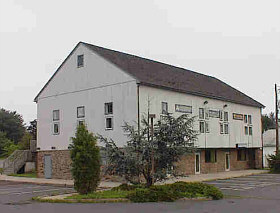| SOCIETY |
| INDENHOFEN FARM |
| SKIPPACK HISTORY |
| REVOLUTIONARY WAR |
| ARCHITECTURE |
| CREAMERY VILLAGE |
| LINKS |
| ABOUT | SUPPORT | UPCOMING | IN THE NEWS |
| Walter Janson (Johnson) Farm |
A brief history of the barn and site located at Rt.73 & Rt.113, NE corner, Skippack, Pa
 This site was part of the Walter Johnson farm of 1745-94, and the location of his house and barn, which is still standing. In 1749, he acquired the land from his father, Peter Jansen (Johnson), who bought 200 acres in 1723 and divided it among his 4 children. Walter was appointed census taker by the provisional government. He took the area's first census in 1756. Walter's mother was Catharine Dock, daughter of Christopher Dock, the famous and highly respected schoolmaster of the Mennonites. Dock taught at the meetinghouses in both Skippack and Philadelphia. Dock taught in Skippack over the period from 1718-1771 when he was found dead at his schoolhouse in a position of prayer. Dock was also the first author in America of a book on educating children. The author Marguerite De Angeli published the book "Skippack School", in 1939, which is written around schoolmaster Dock. The respected, private Christopher Dock High School, in nearby Towamencin, bears his name. Dock owned a farm north of Skippack off the Rt.113 roadway, which was laid out in 1726. For over 20 years, schoolmaster Dock road his horse past his grandson Walter's farm, traveling between his own farm near Woxall and the schoolhouse at the Lower Skippack Mennonite church. This site's barn of Walter Johnson stands today as the only representation in Skippack as a structure likely visited by Christopher Dock.
This site was part of the Walter Johnson farm of 1745-94, and the location of his house and barn, which is still standing. In 1749, he acquired the land from his father, Peter Jansen (Johnson), who bought 200 acres in 1723 and divided it among his 4 children. Walter was appointed census taker by the provisional government. He took the area's first census in 1756. Walter's mother was Catharine Dock, daughter of Christopher Dock, the famous and highly respected schoolmaster of the Mennonites. Dock taught at the meetinghouses in both Skippack and Philadelphia. Dock taught in Skippack over the period from 1718-1771 when he was found dead at his schoolhouse in a position of prayer. Dock was also the first author in America of a book on educating children. The author Marguerite De Angeli published the book "Skippack School", in 1939, which is written around schoolmaster Dock. The respected, private Christopher Dock High School, in nearby Towamencin, bears his name. Dock owned a farm north of Skippack off the Rt.113 roadway, which was laid out in 1726. For over 20 years, schoolmaster Dock road his horse past his grandson Walter's farm, traveling between his own farm near Woxall and the schoolhouse at the Lower Skippack Mennonite church. This site's barn of Walter Johnson stands today as the only representation in Skippack as a structure likely visited by Christopher Dock.
Description:
A barn remaining from the Walter Johnson farm of 1745 - 1794. The barn is an example of a German-Swiss style known as a "Bank Barn" as it was built into a bank or sloping land giving added protection to animals during the winter, having the stable on the lower level and the threshing floor above. It is in beautiful condition, renovated in the early 1980's. It stands on the original foundation and wood beam infrastructure although the wood siding was replaced after a fire in 1937.
History:
Peter Jansen married Catharine Dock, daughter of Christopher Dock. During the 1700's Christopher Dock was a highly respected schoolmaster and played an important role in the history of early America and education, as well as of Skippack and the Mennonite culture. He was the author of the first book on education to be published in America. His farm was located near Woxall, north of Skippack.
In 1723, Peter Jansen purchased land of Gerhard Indenhofen, from Rt. 113 to Store Rd., and later divided it into four rectangular sections for each of his children, Walter, Mary, William and Agnes. In 1745, his son Walter received the land at NE corner of Rt.113 & Rt.73 extending north. He maintained his farm from 1745 to 1794. Walter was the resident constable and tax collector, completing a census in 1756 as ordered by the provisional government.
Christopher Dock taught during the period of ownership of his grandson Walter Johnson's farm. As Rt.113 was constructed about 1726, it would be the likely route taken by Dock between his farm and the school where he taught at Lower Skippack Mennonite. Since Dock taught for many years, it is likely that Walter received frequent visits of his grandfather to his farm.
The original Johnson house was replaced by another larger house in 1817 by Joseph Reiff who ran a hotel here for many years. This was torn down about 1980.
This structure-site may be the only one that can be said with certainty that Christopher Dock had visited here and walked on this ground. In his time, he was widely known and highly respected for his teaching practices. He is as famous regionally as Thomas Jefferson is nationally.
Researched and written by Mike Dickey
Member of Skippack Historical Society
This web site was designed and donated by Lederach Associates Architect + Engineers.